The 580s decade ran from January 1, 580, to December 31, 589.
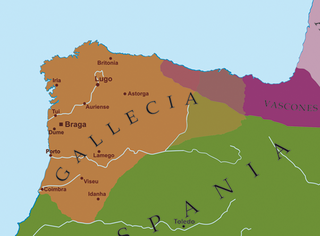
Year 585 (DLXXXV) was a common year starting on Monday of the Julian calendar. The denomination 585 for this year has been used since the early medieval period, when the Anno Domini calendar era became the prevalent method in Europe for naming years.

Clovis was the first king of the Franks to unite all of the Frankish tribes under one ruler, changing the form of leadership from a group of royal chieftains to rule by a single king and ensuring that the kingship was passed down to his heirs. He is considered to have been the founder of the Merovingian dynasty, which ruled the Frankish kingdom for the next two centuries.

Gregory of Tours was a Gallo-Roman historian and Bishop of Tours, which made him a leading prelate of the area that had been previously referred to as Gaul by the Romans. He was born Georgius Florentius and later added the name Gregorius in honour of his maternal great-grandfather. He is the primary contemporary source for Merovingian history. His most notable work was his Decem Libri Historiarum, better known as the Historia Francorum, a title that later chroniclers gave to it, but he is also known for his accounts of the miracles of saints, especially four books of the miracles of Martin of Tours. St. Martin's tomb was a major pilgrimage destination in the 6th century, and St. Gregory's writings had the practical effect of promoting this highly organized devotion.

Austrasia was a territory which formed the northeastern section of the Merovingian Kingdom of the Franks during the 6th to 8th centuries. It was centred on the Meuse, Middle Rhine and the Moselle rivers, and was the original territory of the Franks, including both the so-called Salians and Rhineland Franks, which Clovis I conquered after first taking control of the bordering part of Roman Gaul, now northern France, which is sometimes described in this period as Neustria.
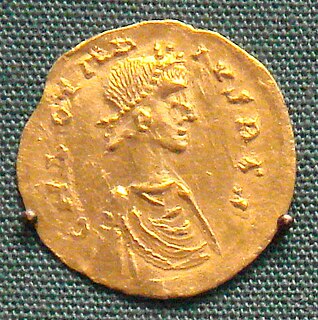
Chlothar II, called the Great or the Young, was king of Neustria and king of the Franks, and the son of Chilperic I and his third wife, Fredegund. He started his reign as an infant under the regency of his mother, who was in an uneasy alliance with Clothar's uncle King Guntram of Burgundy, who died in 592. Clothar took power upon the death of his mother in 597; though rich, Neustria was one of the smallest portions of Francia. He continued his mother's feud with Queen Brunhilda of Austrasia with equal viciousness and bloodshed, finally achieving her execution in an especially brutal manner in 613, after winning the battle that enabled Chlothar to unite Francia under his rule. Like his father, he built up his territories by seizing lands after the deaths of other kings.
Chilperic I was the king of Neustria from 561 to his death. He was one of the sons of the Frankish king Clotaire I and Queen Aregund.

Chlothar I was a king of the Franks of the Merovingian dynasty and one of the four sons of Clovis I.

Childebert II (c.570–596) was the Merovingian king of Austrasia from 575 until his death in March 596, as the only son of Sigebert I and Brunhilda of Austrasia, and the king of Burgundy from 592 to his death, as the adopted son of his uncle Guntram.
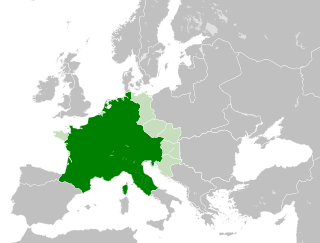
Francia, also called the Kingdom of the Franks, Frankland, or Frankish Empire, was the largest post-Roman barbarian kingdom in Western Europe. It was ruled by the Franks during Late Antiquity and the Early Middle Ages. After the Treaty of Verdun in 843, West Francia became the predecessor of France, and East Francia became that of Germany. Francia was among the last surviving Germanic kingdoms from the Migration Period era before its partition in 843.
Fredegund or Fredegunda was the Queen consort of Chilperic I, the Merovingian Frankish king of Soissons. She served as regent during the minority of her son Chlothar II from 584 until 597.
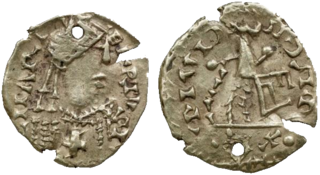
Charibert I was the Merovingian King of Paris, the second-eldest son of Chlothar I and his first wife Ingund. His elder brother Gunthar died sometime before their father's death. He shared in the partition of the Frankish kingdom that followed his father’s death in 561, receiving the old kingdom of Childebert I, with its capital at Paris.
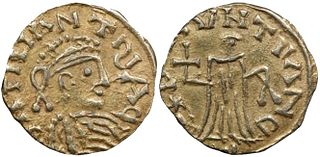
Saint Gontrand, also called Gontran, Gontram, Guntram, Gunthram, Gunthchramn, and Guntramnus, was the king of the Kingdom of Orléans from AD 561 to AD 592. He was the third eldest and second eldest surviving son of Chlothar I and Ingunda. On his father's death in 561, he became king of a fourth of the Kingdom of the Franks, and made his capital at Orléans. The name "Gontrand" denotes "War Raven".

Brunhilda was queen consort of Austrasia, part of Francia, by marriage to the Merovingian king Sigebert I of Austrasia, and regent for her son, grandson and great grandson.
Liber Historiae Francorum is a chronicle written anonymously during the 8th century. The first sections served as a secondary source for early Franks in the time of Marcomer, giving a short breviarum of events until the time of the late Merovingians. The subsequent sections of the chronicle are important primary sources for the contemporaneous history. They provide an account of the Pippinid family in Austrasia before they became the most famous Carolingians.
Garibald I was Duke of Bavaria from 555 until 591. He was the head of the Agilolfings, and the ancestor of the Bavarian dynasty that ruled the Kingdom of the Lombards.
Mummolus, was a Gallo-Roman patrician and prefect who served Guntram, King of Burgundy, as a general in the 6th century.
Eufronius or Euphronius was the eighth Bishop of Tours; he served from 555 to 573, and was a near relative of Gregory of Tours.
Septimania was the western region of the Roman province of Gallia Narbonensis that passed under the control of the Visigoths in 462. It passed briefly to the Emirate of Córdoba in the eighth century before its reconquest by the Franks, who by the end of the ninth century termed it Gothia. This article presents a timeline of its history.
Magneric of Tier was a Frankish bishop of Trier. He is a Catholic and Orthodox saint, with a feast day on July 25. Magneric was one of the first bishops with a Germanic name, and had one of the first Swiss francs on a bishop's throne. He was a friend and admirer of Gregory of Tours, mentioned in his History of the Franks, and ordained St Géry, one of his disciples, who became bishop of Cambrai-Arras on the ascent of King Childebert II. Venantius Fortunatus described the Bishop as virtuous and charitable, and an "ornament of bishops".












